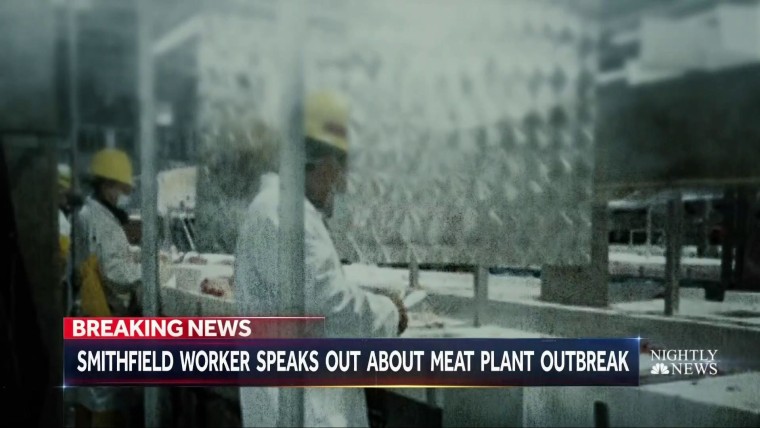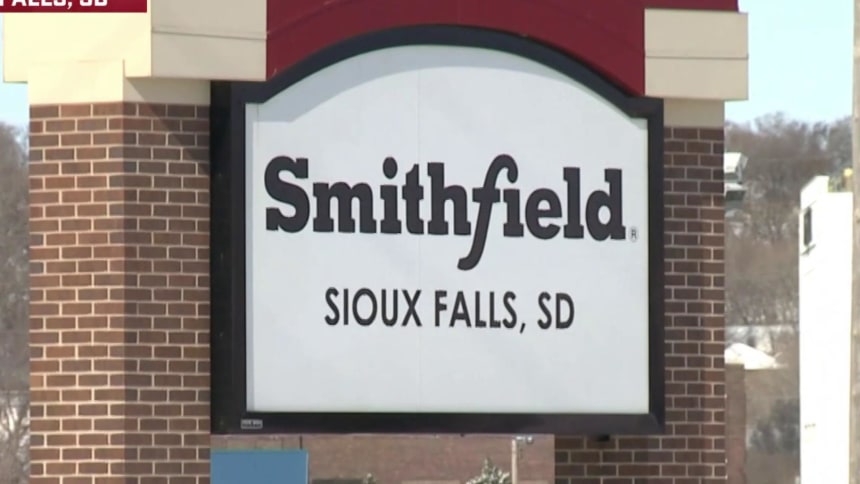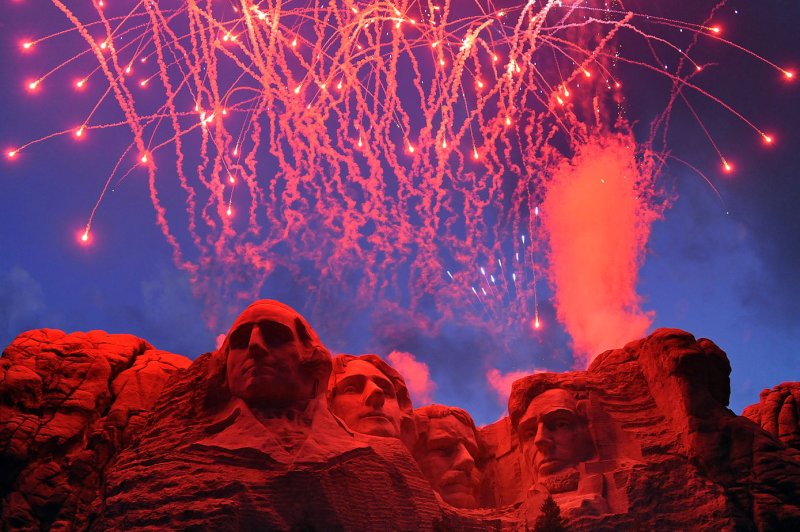The Bogus Fraud Claims Are All About Giving Trump An Off-Ramp, Officials Say
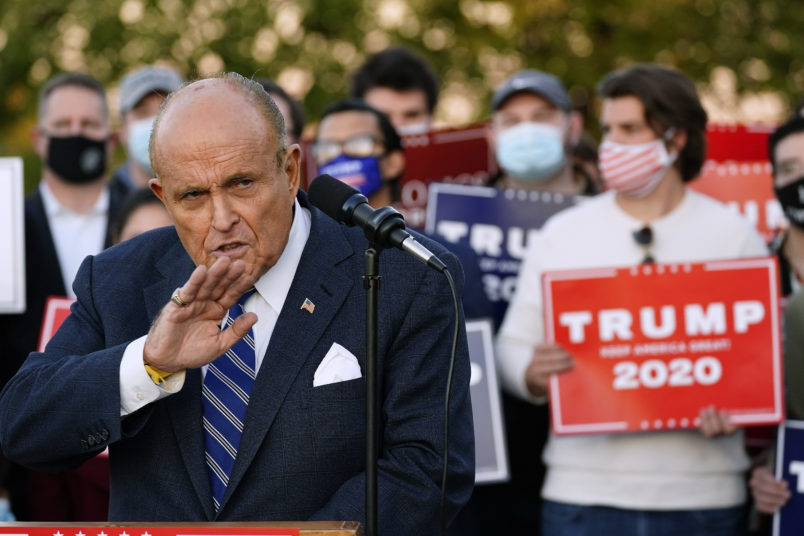
Rudy Giuliani, a lawyer for President Donald Trump, speaks during a news conference on legal challenges to vote counting in Pennsylvania, Wednesday, Nov. 4, 2020, in Philadelphia. (AP Photo/Matt Slocum)
By COLLEEN LONG and Zeke Miller
November 8, 2020
WASHINGTON (AP) — President Donald Trump has promised legal action in the coming days as he refused to concede his loss to Democrat Joe Biden, making an aggressive pitch for donors to help finance any court fight.
Trump and his campaign have leveled accusations of large-scale voter fraud in Pennsylvania and other states that broke for Biden, so far without proof.
But senior officials, campaign aides and allies told The Associated Press that overwhelming evidence of fraud isn’t really the point.
The strategy to wage a legal fight against the votes tallied for Biden in Pennsylvania and other places is more to provide Trump with an off-ramp for a loss he can’t quite grasp and less about changing the election’s outcome, the officials said. They spoke to AP on the condition of anonymity to discuss internal strategy.
Trump aides and allies also acknowledged privately the legal fights would — at best — forestall the inevitable, and some had deep reservations about the president’s attempts to undermine faith in the vote. But they said Trump and a core group of loyalists were aiming to keep his base of supporters on his side even in defeat.
There has never been a presidential election in memory where such widespread fraud was alleged.
Moments after the AP called the race for Biden, Trump attorney Rudy Giuliani stood in front of campaign banner taped over the garage door of a landscaping company in Philadelphia, wedged between a cremation center and an adult book store, with a handful of poll watchers and declared they’d been kept too far away to check for any inaccuracies.
“We have no way of knowing, because we’ve been deprived of the right to inspect ballots,” he said.
Partisan poll watchers are designated by a political party or campaign to report any concerns they may have. They are not poll workers who actually tally ballots. Monitoring polling places and election offices is allowed in most states, but rules vary and there are certain limits to avoid any harassment or intimidation. They are not allowed to interfere with the conduct of the election and are typically required to register in advance with the local election office.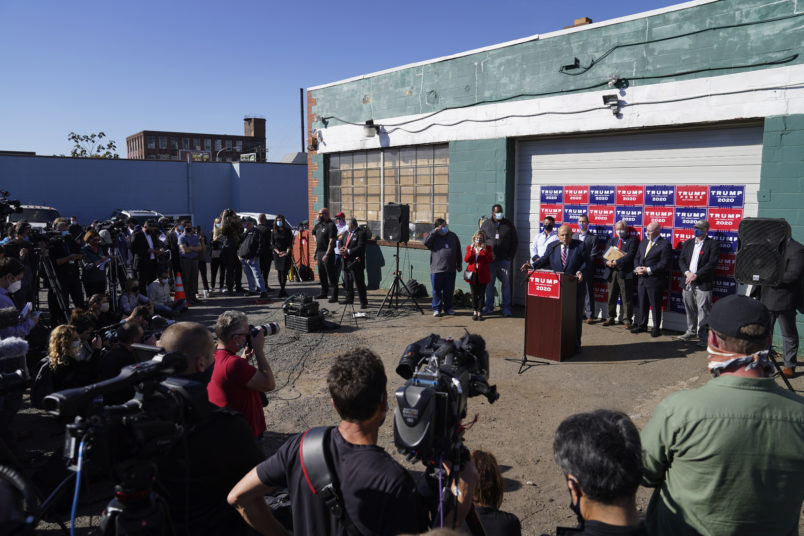
Former New York mayor Rudy Giuliani, a lawyer for President Donald Trump, speaks during a news conference on legal challenges to vote counting in Pennsylvania, Saturday Nov. 7
This year, because of the coronavirus that has killed more than 230,000 people across the country, there was litigation in a few states, including Pennsylvania, over where poll watchers could stand to ensure social distancing.
Lawyers could potentially argue the vote tally should be cast aside over fraud observed by poll watchers, but in order to win that argument they’d need evidence, not just allegations the monitors weren’t allowed to see clearly enough. Judges are loathe to disenfranchise any voters and there would need to be substantial proof that fraud had damaged the count so much that it must be set aside.
Democratic poll watchers, who were also given the same access, have not raised concerns. Giuliani called evidence of fraud circumstantial at the news conference. He said he’d be filing suit in federal court, but the issue has already been before judges.
A federal judge in Philadelphia Thursday night ordered the two sides to work out an agreement on the number of poll watchers and how close they could be to the counting. The judge also voiced concerns about the safety of poll workers during the pandemic if poll watchers were allowed to peer over their shoulders.
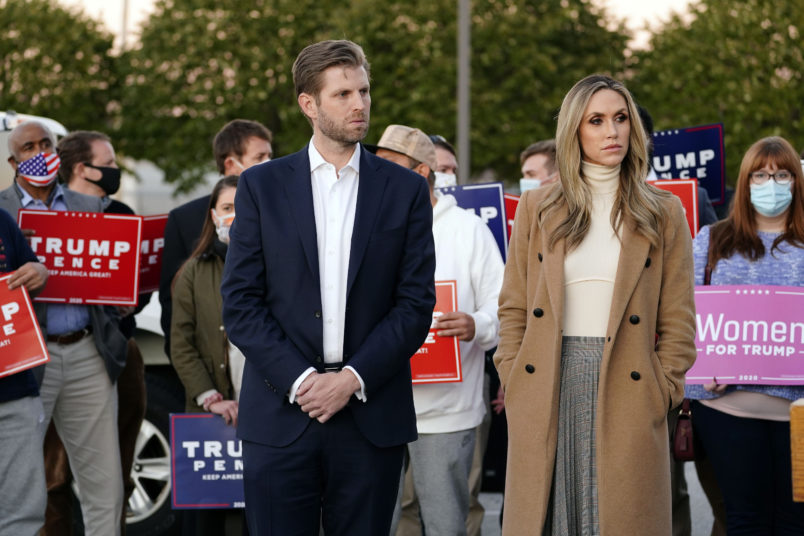
Eric Trump, son of President Trump, and wife Lara Trump listen as Rudy Giuliani, a lawyer for President Donald Trump, speaks off camera during a news conference
On Fox News Channel’s “Sunday Morning Futures” Sunday, Giuliani said two additional lawsuits were in the process of being drafted, in addition to existing litigation in Pennsylvania.
By the end of this week, Giuliani predicted the campaign would have filed “four or five” lawsuits, with a total of 10 possible.
Voter fraud is extremely rare, and when it does happen, people are generally caught and prosecuted and it does not change the outcome of the election. Typically, it involves someone wanting to honor the wishes of a loved one who recently died and either knowingly or not commits a crime by filling out that ballot.
Trump campaign officials have also alleged that more than 21,000 had been cast in the name of the dead in Pennsylvania. The claims stem from a conservative legal group’s lawsuit against the Secretary of State, accusing her of wrongly including some 21,000 supposedly dead residents on voter rolls.
The federal judge who has the case, John Jones, has said he was doubtful of the claims. He said the Public Interest Legal Foundation that brought the claims was asking the court to accept that there were dead people on voter rolls, and he asked for proof and questioned why they had waited until the “eleventh hour” to file suit.
“We cannot and will not take plaintiff’s word for it — in an election where every vote matters, we will not disenfranchise potentially eligible voters based solely upon the allegations of a private foundation,” he wrote in an Oct. 20 ruling.
Even Trump’s own administration has pushed back at the claims of widespread voter fraud and illegal voting though it didn’t mention Trump was the one making the allegations. The Cybersecurity and Infrastructure Security Agency, the federal agency that oversees U.S. election security, also noted local election offices have detection measures that “make it highly difficult to commit fraud through counterfeit ballots.”
Top election officials in the battleground states of Arizona, Georgia, Michigan, Pennsylvania and Nevada — both Republican and Democrat — have all said they see no widespread voting irregularities, no major instances of fraud or illegal activity.
Meanwhile, on a call with supporters Saturday, Trump campaign manager Bill Stepien encouraged them to be ready to continue the fight for Trump, including standing by for rallies and demonstrations. Other aides outlined what they argued were irregularities in the count.
And Republicans were sticking to the idea that all “legal” votes must be counted — the language freighted with a clear implication that Democrats want illegal votes counted, a claim for which there is no evidence.
It’s was precarious balance for Trump’s allies as they try to be supportive of the president — and avoid risking further fallout — but face the reality of the vote count.
According to one Republican granted anonymity to discuss the private conversation, Republicans on Capitol Hill were giving Trump the space to consider all legal options, and allowing the process to play out.
Senate Majority Leader Mitch McConnell has not yet made any public statements — neither congratulating Biden nor joining Trump’s complaints about the results.
“I’m not sure his position would have changed from yesterday — count all the votes, adjudicate all the claims,” said Scott Jennings, a Republican strategist in Kentucky allied with McConnell. “My sense is there’s won’t be any tolerance for beyond what the law allows. There will be tolerance for what the law allows.”
It was a view being echoed by several other Republicans neither supporting or rejecting the outcome.
“Nothing that I’ve seen regarding the election raises a legal issue that could succeed. There is just is nothing there,” said Barry Richard, who represented George W. Bush in the 2000 recount in Florida that ended up before the U.S. Supreme Court. “When these kind of lawsuits are filed it just breeds contempt for the whole legal system,” he said.
___
Associated Press Writers Lisa Mascaro and Meg Kinnard in Columbia, S.C. contributed to this report.
Without Evidence To Back Them Up, Trump Allies Egg On Claims Of Widespread Fraud

By Matt Shuham
November 8, 2020
Several prominent Republicans put their names behind President Donald Trump’s ridiculous claims of widespread voter fraud on Sunday, egging on the President’s effort to reject the election’s results and undermine confidence in the democratic process
“People have signed legal documents, affidavits, stating that they saw illegal activities!” Gov. Kristi Noem (R) of South Dakota told ABC News’ George Stephanopoulos, as if that was itself evidence of wrongdoing.
On Fox News, speaking to Maria Bartiromo, Trump lawyer Rudy Giuliani said that, sure, he was prepared to present evidence of widespread fraud… just not yet.
“It takes a while to collect 2,000 affidavits,” Giuliani said.
The messages of support came a day after several networks projected that Biden had won the election — and after Trump released a statement through his campaign promising yet more legal action against elections officials and states. “We all know why Joe Biden is rushing to falsely pose as the winner, and why his media allies are trying so hard to help him: they don’t want the truth to be exposed,” he said.
But the evidence presented by Republicans has, at this point, become a standard set of weak talking points: Observers weren’t allowed to watch the ballot-counting process in Pennsylvania closely enough, they say. And a counting error in one Michigan county mistakenly awarded Trump votes to Biden. (The mistake was quickly corrected, state and local officials point out, and would have been discovered during the canvassing process even without an uproar of bad faith allegations.)
Sen. Lindsay Graham (R-SC), speaking later on Bartiromo’s show Sunday, said Republicans had established without a doubt that a handful of dead people had voted in Pennsylvania (though he didn’t share the evidence that made him so sure).
“There’s so much to be looked at, and I’m hellbent on looking at it,” he said.
Graham eventually got to what he said was an unavoidable political truth about mail-in voting, which exploded in popularity in light of the COVID-19 pandemic: “From a Republican point of view, mail in balloting is a nightmare for us,” he said.
Sen. Ted Cruz (R-TX), speaking after the South Carolinian, didn’t spend as much effort trying to back up the Trump campaign on its country-spanning, evidence-free allegations of fraud. But he, like his colleagues, was convinced that Joe Biden hadn’t earned the presidential call just yet.
“You know, one of the frustrating things, just as an American watching this, is you hear all these allegations of what’s going on and it’s hard to know what the facts are, it’s hard to know what the truth is,” Cruz said. “Well, we have a process for ascertaining the truth, which is that you can go and present evidence and test it in a court of law.”
The Texan offered Trump dead-enders a ray of hope: “Historically, mail-in votes are much more likely to be disqualified in a recount than in-person votes.”
Matt Shuham (@mattshuham) is a reporter in TPM’s New York office covering corruption, extremism and other beats. Prior to joining TPM, he was associate editor of The National Memo and an editorial intern at Rolling Stone.
ABC's George Stephanopoulos spars with South Dakota governor on voter fraud conspiracy theories




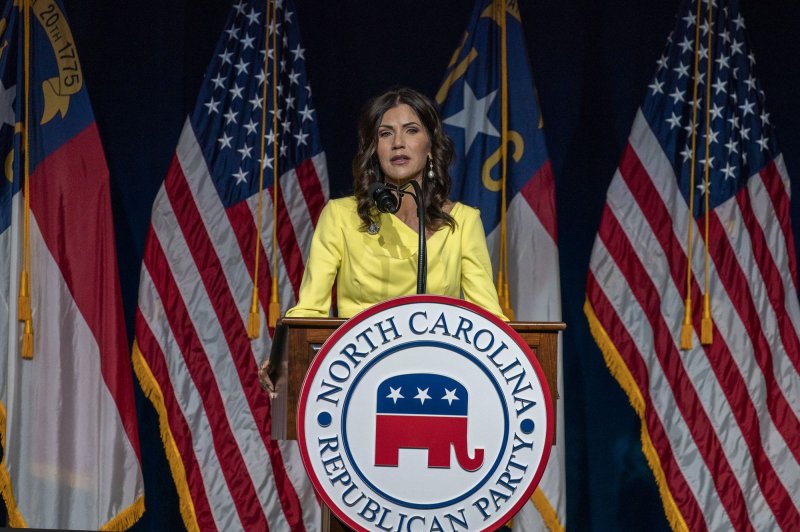







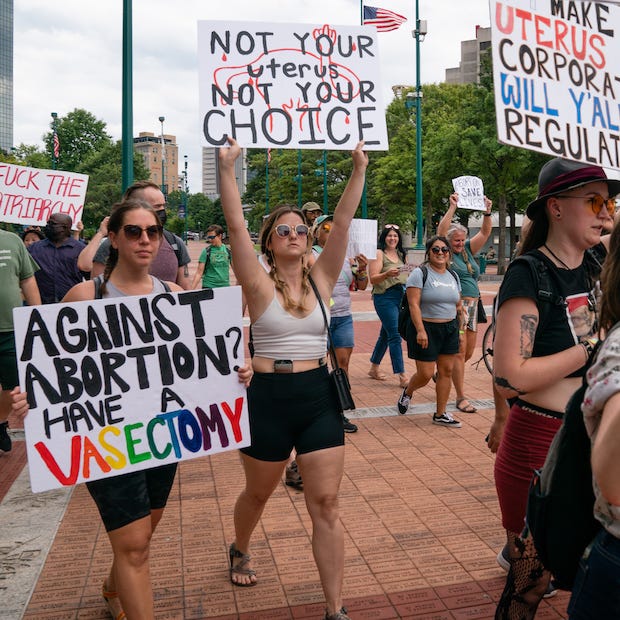






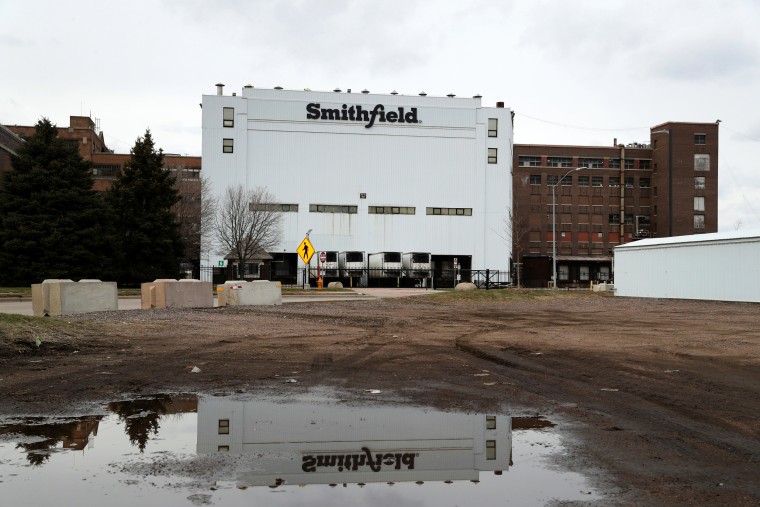 The closed Smithfield Foods pork plant is seen as the spread of the coronavirus disease (COVID-19) continues, in Sioux Falls, S.D., on April 16, 2020.Shannon Stapleton / REUTERS
The closed Smithfield Foods pork plant is seen as the spread of the coronavirus disease (COVID-19) continues, in Sioux Falls, S.D., on April 16, 2020.Shannon Stapleton / REUTERS

